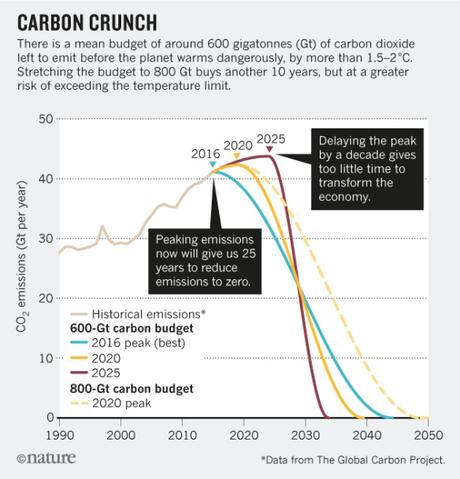It’s Time to Cut CO2 Emissions
Yesterday at my house we received 2.25″ of rain (with hail) in less than an hour. In arid regions, that’s a lot. The gutters clogged with hail, spilled over, and contributed to ponding in the yard that came within 1/4 inch of flowing over the patio door sills. I have a flood wall planned, and hope there’s still time to get it built before another intense storm comes along.
We can expect increasing storm size and intensity because of the amount of CO2 we have already released into the atmosphere. If we could limit emissions and subsequent temperature rise to 1.5 degrees celsius, the storms would continue to grow, but away from the coasts, little flood walls and rooftop solar panels would probably let most of us survive. However, limiting the storms by limiting global temperature increase to 1.5 degrees celsius is impossible now. We might still limit the increase to 2 degrees, but we have to act fast.
The graph below shows the best scientific estimates of the cumulative effect of delays. If emissions begin to fall now, we can stay below 2 degrees of rise if we reach zero by 2040. If emissions do not begin falling until 2025, we must reach zero by 2033 to stay below 2 degrees. Eight years? Having had a strong taste of the coming catastrophe by then, we might try. But the effort itself would be so costly, we probably wouldn’t make it. Dropping to zero in 21 years if we begin now will be incredibly difficult. It will require a global switch to wartime economies dedicated to building renewable energy and making emission cuts. Emissions are still rising as we approach 2020, and reaching zero in 21 years seems unlikely.
All we can count on for sure is that nature will force human emissions to begin falling in about 20 years due to massive loss of life as heatwaves and wildfires increase, and as farms, water delivery, power delivery, and transportation fail. That’s when positive feedbacks, including the ice-free arctic, melting permafrost, soil erosion, and other sources of CO2 will begin growing without our contribution. At that point, our species could begin spiraling down toward extinction.
Christiana Figueres and colleagues published the graph below last year. I blogged about it last December. You can find a link to the original article there.
To keep all this positive, glass half full and so on, I will close by saying that the world’s scientists could be wrong about climate and we will all win the lottery next week.


